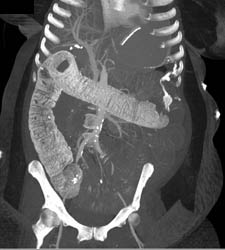

Here, we presented a 46-year-old woman diagnosed as colon ASC through computed tomography (CT) scan and endoscopic examination with abdominal pain and hematochezia for more than 20 days, which was consistently confirmed by pathological examinations of surgical specimen. Surgical resection remains the primary therapy for colorectal ASC, and the prognosis of adenosquamous colon cancer is poorer than AC alone ( 5). Clinical manifestations are similar to colorectal ACs, and the diagnosis is based primarily on histologic examination ( 4). It was described as a cancer containing both adenocarcinoma (AC) and squamous cell carcinoma (SCC) component ( 3).

Primary adenosquamous carcinoma (ASC) of the colon is extremely rare entities ( 1), of which the incidence is around 0.06% of all colorectal cancers ( 2). Accepted for publication Mar 24, 2021.Ĭolorectal cancer is the third most common cancer globally. Keywords: Colorectal cancer adenosquamous carcinoma (ASC) hepatic flexure of colon case report This case promotes the understanding of colon ASC and provides a basis for its clinical diagnosis and treatment. In conclusion, radical resection remains the major treatment for colon ASC, CT scan and endoscopic examination and biopsy are useful for this pre-operative diagnosis. Accordingly, this case was diagnosed as ASC of Stage IIIC (pT4N2M0) and the adjuvant chemotherapy FOLFOX was recommended, while unfortunately the patient refused it for personal reasons. The post-operative pathological examination demonstrated that the tumor was composed of AC (positive for CDX-2 and CK20) and SCC (positive for CK5/6 and P63) components. Furthermore, the multidisciplinary team (MDT) meeting thought laparoscopic right colectomy accompanied with lymphadenectomy was suitable because the clinical stage was at least stage IIIB. Abdominal computed tomography (CT) scanning showed some signs of neoplastic lesion that the wall of the hepatic curvature of the transverse colon is irregularly thicker, the serous surface of the diseased intestinal canal is slightly thicker, and multiple peripheral lymph nodes are enlarged. Results of biopsy suggested a high-grade intraepithelial neoplasia. Then endoscopic examination revealed a hemicircumferential mass in the ascending colon, which contained a friable and ulcerated lesion that bled easily when touched. Laboratory examinations showed a decreased hemoglobin, increased white blood cell (WBC) count, an elevation of the serum levels of CA19-9 and carcinoembryonic antigen (CEA). Physical examination indicated direct tenderness in the navel and lower abdomen distension. Here, we reported that a 46-year-old woman was caught by abdominal pain and hematochezia for more than 20 days and she visited the emergency room with increasing abdominal pain and vomiting for nearly one day. To date, only few cases were recorded previously. ASC is more aggressive for resulting in a poorer prognosis than AC alone. In some cases, Chilaiditi’s syndrome has been associated with breathing problems (respiratory distress).Abstract: Adenosquamous carcinoma (ASC) is defined as a very rare subset of colorectal cancer containing both adenocarcinoma (AC) and squamous cell carcinoma (SCC) components. Affected individuals will not have all of these symptoms and some affected individuals will not have any of these symptoms.Īdditional symptoms that have been reported in Chilaiditi’s syndrome include nausea, vomiting, constipation, indigestion (dyspepsia), abnormal twisting of the intestines (volvulus) causing obstruction, abdominal swelling (distention), difficulty swallowing (dysphagia), and tenderness in the upper, central area of the abdomen (epigastric region). These symptoms can occur together in a wide variety of different combinations. However, abdominal pain can be severe and force affected individuals to go to the emergency room.Īdditional symptoms can occur with Chilaiditi’s syndrome. Abdominal pain may be mild and come and go (intermittent). Chronic, recurrent episodes of abdominal pain are a common finding. The presentation and specific symptoms that develop can be significantly different.

The symptoms of Chilaiditi’s syndrome may vary from one person to another. 5 Myths About Orphan Drugs and the Orphan Drug Act.Information on Clinical Trials and Research Studies.


 0 kommentar(er)
0 kommentar(er)
